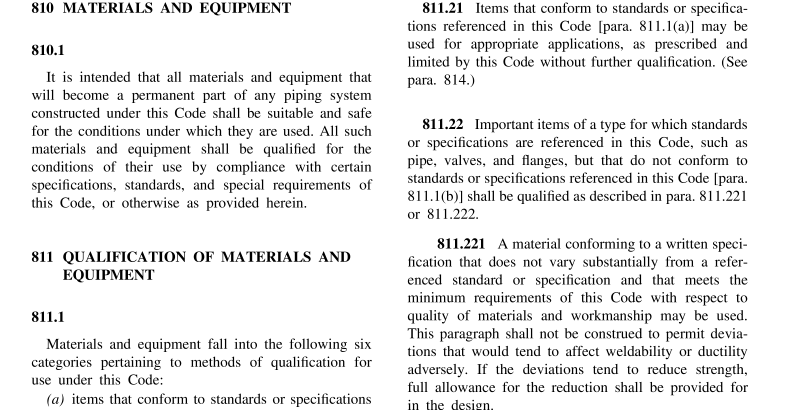ASME B31-8a-2000 pdf free download.CHAPTER I MATERIALS AND EQUIPMENT
816 TRANSPORTATION OF LINE PIPE Any pipe having an outer-diameter-to-wall thickness ratio of 70 to 1 or more, that is to be used in a pipeline at a hoop stress of 20% or more of the specified minimum yield strength that has been or will be transported by railroad, inland waterway, or by marine transportation, must have been or shall be loaded in accordance with API RP5L1 or API RP5LW, respectively. Where it is not possible to establish that pipe was transported in accordance with the appropriate recommended practice, the pipe must be hydrostatically tested for at least 2 hr to at least 1.25 times the maximum allowable operating pressure if installed in a Class 1 location, or to at least 1.5 times the maximum allowable operating pressure if installed in a Class 2, 3, or 4 location.
817 CONDITIONS FOR THE REUSE OF PIPE
817.1 Reuse of Steel Pipe
817.11 Removal of a portion of an existing steel line and reuse of the pipe in the same line or in a line operating at the same or lower pressure is permitted, and is subject to the restrictions of paras. 817.13(a), (f), and (i).
(a) Inspection. All pipe shall be cleaned inside and outside, if necessary, to permit good inspection. All pipe shall be visually inspected to determine that it is reasonably round and straight and to discover any defects that might impair its strength or tightness.
(b) Bending Properties. For pipe NPS 2 and smaller, a sufficient length of pipe shall be bent cold through 90 deg around a cylindrical mandrel, the diameter of which is 12 times the nominal diameter of the pipe, without developing cracks at any portion and without opening the weld. For pipe larger than NPS 2, flattening tests as pre- scribed in Appendix H shall be made. The pipe shall meet the requirements in this test, except that the number of tests required to determine flattening properties shall be the same as required in subpara. (g) below to determine yield strength.
(c) Determination of Wall Thickness. Unless the nominal wall thickness is known with certainty, it shall be determined by measuring the thickness at quarter points on one end of each piece of pipe. If the lot of pipe is known to be of uniform grade, size, and nominal thickness, measurement shall be made on not less than 10% of the individual lengths, but not less than 10 lengths; thickness of the other lengths may be verified by applying a gage set to the minimum thickness. Following such measurement, the nominal wall thick- ness shall be taken as the next commercial wall thickness below the average of all the measurements taken, but in no case greater than
1.14 times the least measured thickness for all pipe smaller than NPS 20, and no greater than 1.11 times the least measured thickness for all pipe NPS 20 and larger.
(d) Longitudinal Joint Factor. If the type of longitu- dinal joint can be determined with certainty, the corres- ponding longitudinal joint factor, E (Table 841.115A in Chapter IV), may be used. Otherwise, E shall be taken as 0.60 for pipe NPS 4 and smaller, or 0.80 for pipe larger than NPS 4.
(e) Weldability. Weldability shall be determined as follows. A qualified welder shall make a girth weld in the pipe. The weld shall then be tested in accordance with requirements of API 1104. The qualifying weld shall be made under the most severe conditions under which welding will be permitted in the field and using the same procedure as to be used in the field. The pipe shall be considered weldable if the requirements set forth in API 1104 are met. At least one such test weld shall be made for each 100 lengths of pipe on sizes larger than NPS 4. On sizes NPS 4 and smaller, one test will be required for each 400 lengths of pipe. If in testing the weld the requirements of API 1104 cannot be met, the weldability may be established by making chemical tests for carbon and manganese (see para. 823.23), and proceeding in accordance with the provisions of the ASME Boiler and Pressure Vessel Code, Section IX. The number of chemical tests shall be the same as required for circumferential weld tests stated above.
(f) Surface Defects. All pipe shall be examined for gouges, grooves, and dents and shall be qualified in accordance with the provisions of para. 841.24.
(g) Determination ofYield Strength. When the manu- facturer’s specified minimum yield strength, tensile strength, or elongation for the pipe is unknown, and no physical tests are made, the minimum yield strength for design shall be taken as not more than 24,000 psi. Alternatively, the tensile properties may be established as follows. ASME B31-8a pdf download.ASME B31-8a-2000 pdf free download
